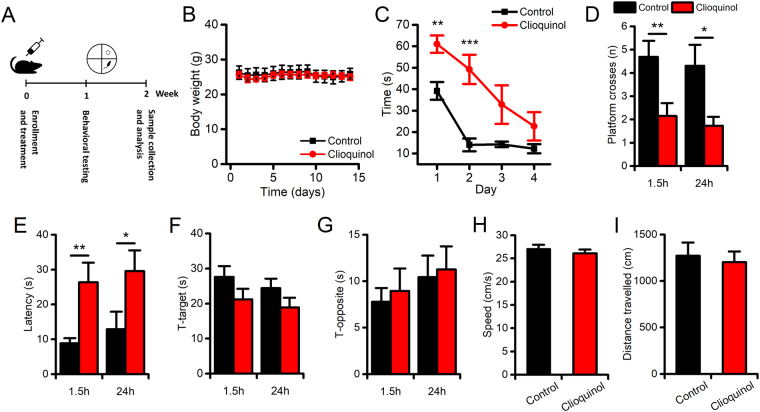Figure 1.
CQ administration impairs learning and memory performances in mice. Spatial memory performances were evaluated with the MWM test. (A) The pictogram illustrates the study design. (B) The graph illustrates the daily body weight monitoring of vehicle- and CQ-treated mice during the 2-week treatment period (n = 8 per study group). (C) The graph illustrates the learning curve of the vehicle- and CQ-treated mice (n = 9 and n = 10, respectively) as evaluated during the 4-day training session. Compared to vehicle-treated animals, CQ-treated mice showed significantly impaired learning performances in the first 3 trials of the training sessions. Note that the impairment disappeared in the fourth day of training. (D) The bar graph shows CQ-driven decreases in the number of platform crosses (the number of times the mouse crosses the location where the platform used to be) in the 1.5 h (to evaluate STM) and the 24 h (to evaluate LTM) trials. (E) The bar graph shows CQ-driven increases of latency (the time spent to reach the location where the platform used to be) in both the STM and the LTM trials. (F,G) Bar graphs show the absence of drug-related changes in the time spent in the target (the quadrant where the platform used to be) or the opposite (the quadrant opposed to the one where the platform used to be) quadrants, in the STM and LTM trials (F and G, respectively). (H) The bar graph shows no CQ-driven changes in swimming speed in LTM trials in a subset of mice (n = 5 for control and n = 4 for CQ-treated mice). (I) The bar graph shows no CQ-driven changes in distance travelled in LTM trials in a subset of mice (n = 5 for control and n = 4 for CQ-treated mice). Data are presented as mean ± standard error of the mean (SEM). “*” indicates p < 0.05, “**” indicates p < 0.01.

